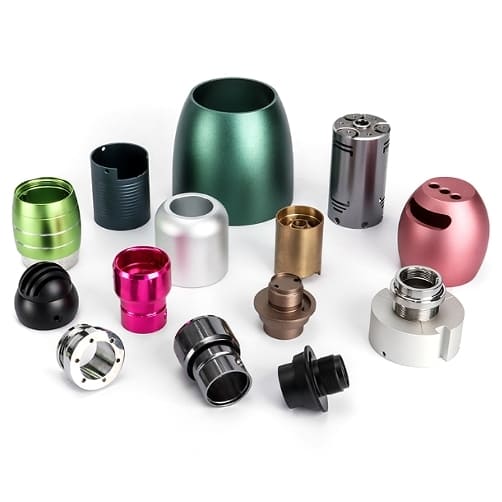CNC precision machining has revolutionized modern manufacturing, making it possible to create highly accurate and complex components with ease. But what exactly is CNC precision machining, and why is it crucial for industries like aerospace, medical, and automotive? Understanding its principles can help you appreciate its significance.
CNC precision machining is an automated manufacturing process that uses computer-controlled tools to produce high-precision metal and plastic components. It ensures superior accuracy, repeatability, and efficiency across industries that demand consistent, high-quality parts.
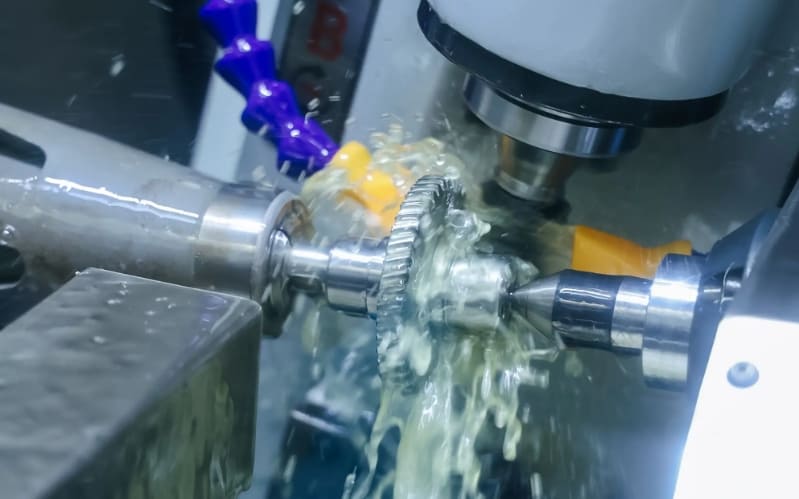
From different types of CNC machines to material selection and machining processes, let’s explore everything you need to know about CNC precision machining.
What are the 5 common types of CNC machines?
The right CNC machine can make all the difference in achieving precision and efficiency. With various types available, each designed for specific tasks, how do you choose the right one? Knowing the most common CNC machines will help you understand their role in manufacturing.
The five most common types of CNC machines are CNC milling machines, CNC lathes, CNC grinding machines, CNC routers, and Electrical Discharge Machines (EDM). Each machine serves a unique purpose, ensuring precision and efficiency in different machining applications.
1. CNC Milling Machines
CNC milling machines use rotary cutting tools to remove material from a workpiece. These machines operate along multiple axes (typically 3 to 5) and are ideal for creating complex shapes and contours. Industries like aerospace and medical heavily rely on CNC milling for high-precision parts.
2. CNC Lathes
CNC lathes rotate the workpiece against a cutting tool to shape it into symmetrical designs. They are best suited for producing cylindrical parts such as shafts, bushings, and fittings. The automotive and industrial equipment industries frequently use CNC lathes.
3. CNC Grinding Machines
CNC grinding machines use abrasive wheels to achieve ultra-fine finishes and precise tolerances. These machines are essential for high-precision components such as bearings, gears, and aerospace engine parts.
4. CNC Routers
CNC routers are primarily used for cutting and engraving softer materials like wood, plastic, and composites. They are commonly found in furniture manufacturing, signage production, and prototyping industries.
5. Electrical Discharge Machines (EDM)
EDM machines remove material using electrical sparks, allowing for the machining of hard metals and intricate geometries that would be challenging with conventional tools. They are widely used in mold-making and aerospace applications.
How does CNC Precision Machining work?
CNC machining delivers unparalleled accuracy, but how does it actually transform raw materials into precise components? The process involves multiple steps, each contributing to the final product’s quality and precision.
CNC precision machining follows a programmed set of instructions (G-code) to control cutting tools, ensuring accurate shaping, drilling, and milling of materials. This eliminates human error and guarantees consistency in production.
Key Steps in CNC Machining
- Design & CAD Modeling – Engineers create a digital blueprint of the component using CAD (Computer-Aided Design) software.
- CAM Programming – CAM (Computer-Aided Manufacturing) software converts the CAD model into G-code, the language CNC machines use.
- Machine Setup – The workpiece is secured, and the appropriate tools are selected for machining.
- Machining Process – The CNC machine follows the G-code instructions, precisely cutting, drilling, or milling the material.
- Quality Control & Inspection – The final component undergoes rigorous quality checks using measuring instruments like calipers and CMMs.
This automated process ensures uniformity, making CNC machining indispensable for industries requiring high-precision components.
What are the industries application of CNC Precision Machining?
Precision is crucial in many industries, but which ones rely most on CNC machining? From aerospace to medical technology, CNC precision machining plays a critical role in producing parts that meet stringent quality standards.
Industries such as aerospace, medical, automotive, electronics, and robotics depend on CNC precision machining for manufacturing complex and high-accuracy parts that meet strict quality standards.

1. Aerospace Industry
Aircraft components require extreme precision and durability. CNC machining produces turbine blades, engine parts, and landing gear components with tight tolerances.
2. Medical Industry
Medical implants, surgical instruments, and prosthetic devices must meet high accuracy and biocompatibility standards. CNC machining ensures that parts like titanium bone plates and dental implants are manufactured with exact precision.
3. Automotive Industry
CNC machining plays a crucial role in manufacturing engine parts, transmission components, and suspension systems. High precision ensures vehicle safety and performance.
4. Electronics Industry
Miniature components such as circuit board housings, connectors, and heat sinks require CNC precision machining to meet the demands of modern electronic devices.
5. Robotics & Automation
Robot arms, actuators, and gear systems require high-precision parts to function seamlessly. CNC machining provides the accuracy needed for robotics applications.
What materials can be used in CNC Precision Machining?
The success of a CNC-machined part depends not only on the machining process but also on the material used. Some materials offer strength, while others provide flexibility, corrosion resistance, or thermal stability. Selecting the right material is essential for achieving the desired performance, durability, and cost-effectiveness of the final product.
CNC precision machining can process a variety of materials, including metals such as aluminum, steel, and titanium, as well as plastics like ABS, POM, and nylon. Each material has unique properties suited for different applications.
Let’s explore the most commonly used metals and plastics in CNC machining, their properties, and their applications.
Common Metals Used in CNC Machining
Metals are widely used in CNC machining due to their strength, durability, and ability to withstand high temperatures. Different metals offer varying levels of machinability, hardness, and corrosion resistance.
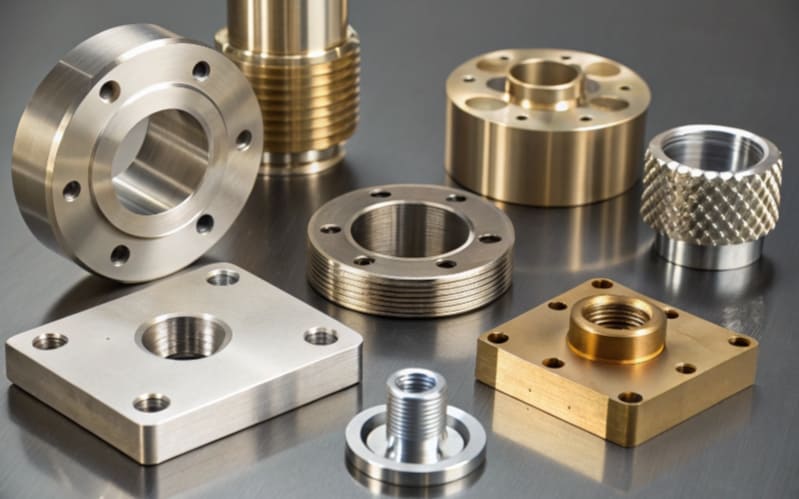
Aluminum
Properties: Lightweight, corrosion-resistant, excellent thermal and electrical conductivity, easy to machine.
Applications: Aerospace components, automotive parts, electronics housings, and medical devices.
Advantages: High machinability and good strength-to-weight ratio make aluminum a popular choice in CNC machining.
Stainless Steel
Properties: Strong, corrosion-resistant, high-temperature resistance, durable.
Applications: Medical implants, food processing equipment, automotive components, and industrial tools.
Advantages: Ideal for applications requiring high wear resistance and exposure to harsh environments.
Carbon Steel
Properties: High strength, tough, relatively inexpensive compared to stainless steel.
Applications: Mechanical parts, gears, and structural components in the automotive and industrial sectors.
Advantages: Excellent strength and durability, though it requires surface treatment to prevent rusting.
Titanium
Properties: High strength-to-weight ratio, corrosion-resistant, biocompatible, withstands extreme temperatures.
Applications: Aerospace engine components, medical implants, military equipment.
Advantages: Lightweight yet strong, making it perfect for high-performance applications. However, it is more expensive and harder to machine than aluminum or steel.
Brass
Properties: Corrosion-resistant, good electrical conductivity, excellent machinability.
Applications: Electrical connectors, plumbing components, and decorative fittings.
Advantages: Easy to machine with a smooth finish, commonly used in precision applications.
Copper
Properties: Excellent electrical and thermal conductivity, corrosion-resistant, ductile.
Applications: Electrical components, heat exchangers, plumbing systems.
Advantages: Ideal for applications that require high thermal or electrical conductivity, such as heat sinks.
Magnesium
Properties: Very lightweight, good strength, high machinability.
Applications: Aerospace and automotive industries, where reducing weight is critical.
Advantages: One of the lightest structural metals, making it useful for lightweight, high-performance parts.
Common Plastics Used in CNC Machining
Plastics offer unique advantages such as chemical resistance, electrical insulation, and reduced weight. They are widely used in applications where metals would be too heavy, conductive, or expensive.
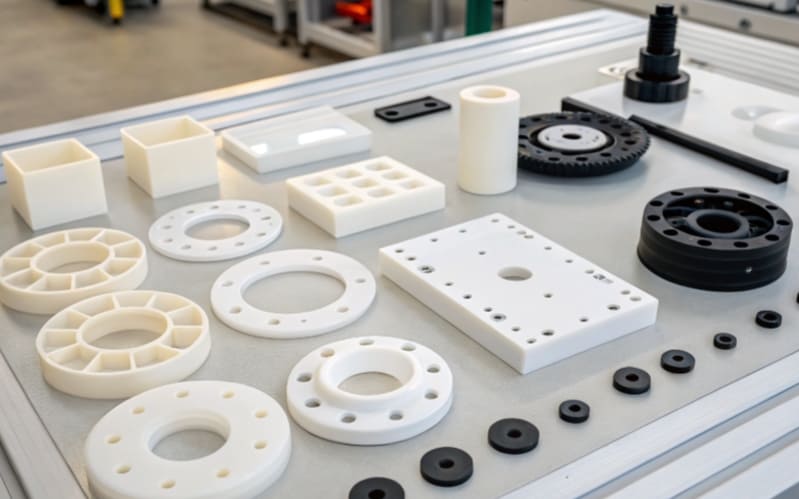
ABS (Acrylonitrile Butadiene Styrene)
Properties: Impact-resistant, lightweight, durable, cost-effective.
Applications: Consumer electronics, automotive components, prototyping, enclosures.
Advantages: Easy to machine and widely used in manufacturing prototypes and plastic housings.
POM (Polyoxymethylene) / Delrin
Properties: High stiffness, low friction, excellent wear resistance.
Applications: Gears, bearings, automotive components, conveyor belts.
Advantages: Ideal for mechanical parts that require low friction and high precision.
Nylon
Properties: Strong, impact-resistant, chemical-resistant, wear-resistant.
Applications: Industrial bushings, pulleys, insulators, medical components.
Advantages: Provides excellent strength and flexibility, suitable for applications requiring durability and wear resistance.
PEEK (Polyether Ether Ketone)
Properties: High-temperature resistance, chemical-resistant, strong, lightweight.
Applications: Aerospace, medical implants, automotive, semiconductor manufacturing.
Advantages: One of the most durable and heat-resistant plastics, often used as a metal replacement in extreme environments.
PTFE (Teflon)
Properties: Chemical-resistant, high-temperature resistant, non-stick properties.
Applications: Seals, gaskets, medical devices, and food processing equipment.
Advantages: Excellent electrical insulation and chemical resistance, making it suitable for harsh environments.
Polycarbonate (PC)
Properties: High impact resistance, transparent, heat-resistant.
Applications: Protective covers, lenses, medical devices.
Advantages: Stronger than glass and widely used for safety applications.
Acrylic (PMMA – Polymethyl Methacrylate)
Properties: Transparent, lightweight, shatter-resistant.
Applications: Display cases, signage, lighting applications.
Advantages: Provides glass-like clarity with improved durability.
3. Composite Materials Used in CNC Machining
Some industries require materials that combine the best properties of metals and plastics. Composite materials offer unique advantages in weight reduction, strength, and performance.
Fiberglass (GFRP – Glass Fiber Reinforced Polymer)
Properties: Strong, lightweight, corrosion-resistant.
Applications: Aerospace, automotive, sporting goods.
Advantages: Provides high strength-to-weight ratio, often used as a replacement for metals.
Carbon Fiber Reinforced Polymer (CFRP)
Properties: Extremely strong, lightweight, heat-resistant.
Applications: Aerospace, automotive, high-performance sporting goods.
Advantages: Used in applications where weight reduction and high strength are essential.
4. Choosing the Right Material for CNC Machining
The choice of material depends on various factors, including:
✅ Strength Requirements – Metals like titanium and steel are ideal for high-strength applications.
✅ Weight Considerations – Aluminum and magnesium provide lightweight alternatives.
✅ Corrosion Resistance – Stainless steel, titanium, and plastics like PTFE offer excellent resistance to chemicals and moisture.
✅ Electrical & Thermal Properties – Copper and aluminum have superior conductivity, while plastics like PEEK provide insulation.
✅ Cost & Machinability – Aluminum and brass are easy to machine and cost-effective, while titanium and advanced plastics like PEEK are more expensive but provide specialized benefits.
Selecting the right material is essential for ensuring performance, durability, and cost-effectiveness.
What are the different types of CNC Machining processes?
CNC machining isn’t just about cutting and shaping—it involves multiple processes, each designed to achieve different results. Depending on the complexity, material, and application of the part, manufacturers use different machining techniques to ensure precision, efficiency, and optimal surface finish.
The most common CNC machining processes include milling, turning, drilling, grinding, and Electrical Discharge Machining (EDM). Each process serves a unique function, ensuring high precision for various applications.
Let’s explore each of these CNC machining processes in detail.
1. CNC Milling
CNC milling is one of the most widely used machining processes. It involves using rotary cutting tools to remove material from a workpiece, shaping it into the desired form.
How It Works:
The workpiece is secured on a stationary bed, while a rotating cutting tool moves along multiple axes (typically 3 to 5) to carve out the shape.
The cutting tool moves in the X, Y, and Z directions to create complex geometries, holes, and slots.
Applications:
✅ Aerospace components
✅ Automotive engine parts
✅ Medical devices
✅ Prototyping and mold making
Advantages:
✔️ Highly precise and versatile
✔️ Suitable for complex geometries
✔️ Works with metals, plastics, and composites
Types of CNC Milling Machines:
3-Axis Milling – Moves along X, Y, and Z directions (basic but effective for most tasks).
4-Axis Milling – Adds rotation around the X-axis for increased flexibility.
5-Axis Milling – Allows rotation around both the X and Y axes, enabling highly intricate designs.
2. CNC Turning(Lathe Machining)
CNC turning is used to create cylindrical parts by rotating the workpiece against a stationary cutting tool.
How It Works:
The workpiece is clamped and spun at high speeds while the cutting tool moves along the length to shape it.
CNC lathes can perform cutting, drilling, and threading operations.
Applications:
✅ Shafts and rods
✅ Bushings and bearings
✅ Pipe fittings
✅ Automotive and aerospace parts
Advantages:
✔️ Ideal for symmetrical, round, or cylindrical parts
✔️ Faster production for high-volume runs
✔️ High surface finish and accuracy
Types of CNC Turning Machines:
2-Axis Lathes – Basic lathes with two-axis movement (X and Z).
Multi-Axis Lathes (3 to 5 Axes) – Advanced versions with additional axes for increased complexity.
Swiss Lathes – Highly precise machines used for small, intricate parts like watch components.
3. CNC Drilling
CNC drilling is used to create precise holes in a workpiece, often as a preliminary step before further machining.
How It Works:
A rotating drill bit is fed into the material at a controlled speed and depth.
CNC drilling machines ensure hole placement accuracy and depth uniformity.
Applications:
✅ Bolt holes in machine parts
✅ Circuit board drilling
✅ Automotive engine components
Advantages:
✔️ High precision in hole placement
✔️ Consistent depth and diameter
✔️ Can be combined with other machining processes
Types of CNC Drilling Operations:
Spot Drilling – Creates small pilot holes to guide larger drills.
Deep Hole Drilling – Used for making deep holes with high accuracy.
Tapping – Adds threads inside pre-drilled holes.
4. CNC Grinding
CNC grinding is used for finishing surfaces with extreme precision, producing high-quality finishes and tight tolerances.
How It Works:
A grinding wheel removes small amounts of material to refine the surface of a workpiece.
CNC grinders use high-speed rotating abrasive wheels to smooth and shape metal, ceramic, and composite parts.
Applications:
✅ Aerospace engine components
✅ Bearings and gears
✅ Medical implants
Advantages:
✔️ Ultra-precise tolerances (as low as ±0.001mm)
✔️ Produces smooth, polished surfaces
✔️ Essential for finishing hardened metals
Types of CNC Grinding Machines:
Surface Grinders – Create flat surfaces with high precision.
Cylindrical Grinders – Used for round objects like shafts and rollers.
Centerless Grinders – Ideal for mass-producing precision cylindrical parts.
5. Electrical Discharge Machining (EDM)
EDM is a non-traditional machining process that removes material using electrical sparks instead of cutting tools.
How It Works:
A high-frequency electrical discharge (spark) erodes the material, shaping it into the desired form.
The process is performed in a dielectric fluid that helps control the spark and prevent overheating.
Applications:
✅ Hard metal components (tooling and dies)
✅ Complex internal cavities
✅ Aerospace and medical parts
Advantages:
✔️ Can machine hard metals (titanium, tungsten, carbide)
✔️ No mechanical stress on the workpiece
✔️ Allows intricate shapes that traditional machining can’t achieve
Types of EDM Machines:
Wire EDM – Uses a thin wire to cut intricate shapes.
Sinker EDM – Uses shaped electrodes to create complex cavities.
6. CNC Plasma Cutting
CNC plasma cutting uses a high-speed jet of ionized gas (plasma) to cut through electrically conductive materials.
How It Works:
A plasma torch generates extreme heat (up to 30,000°F), melting and cutting through metal.
The machine follows programmed paths to create precise cuts.
Applications:
✅ Metal fabrication and sheet metal cutting
✅ Automotive chassis components
✅ Custom metal artwork
Advantages:
✔️ Fast cutting speeds
✔️ Works on thick and hard metals
✔️ Cost-effective for large-scale production
7. CNC Water Jet Cutting
Water jet cutting uses a high-pressure stream of water (sometimes mixed with abrasives) to cut through various materials.
How It Works:
Water is pressurized up to 60,000 PSI and focused through a small nozzle.
Abrasive particles (such as garnet) can be added to increase cutting power.
Applications:
✅ Cutting composites, metals, glass, and ceramics
✅ Aerospace and automotive parts
✅ Stone and tile manufacturing
Advantages:
✔️ No heat-affected zones (ideal for heat-sensitive materials)
✔️ Can cut almost any material
✔️ High precision with smooth edges
8. CNC Laser Cutting
CNC laser cutting uses a high-powered laser beam to cut or engrave materials with extreme precision.
How It Works:
A focused laser beam melts, burns, or vaporizes material along the programmed path.
Works best with thin metals, plastics, and composites.
Applications:
✅ Sheet metal components
✅ Electronic enclosures
✅ Engraving custom designs on materials
Advantages:
✔️ High precision with fine details
✔️ No direct contact with the material
✔️ Can cut, engrave, or etch designs
By understanding the different types of CNC machining processes, manufacturers can select the best method to achieve the desired results for their specific applications.
What code is used for CNC machining program?
CNC machines don’t operate on their own—they require precise programming to function correctly. But what kind of code is used to control these high-precision machines? Understanding the language behind CNC machining is crucial for achieving optimal results.
G code is the primary programming language used in CNC machining. It dictates tool movements, cutting speeds, and other machining parameters, ensuring precision and consistency.
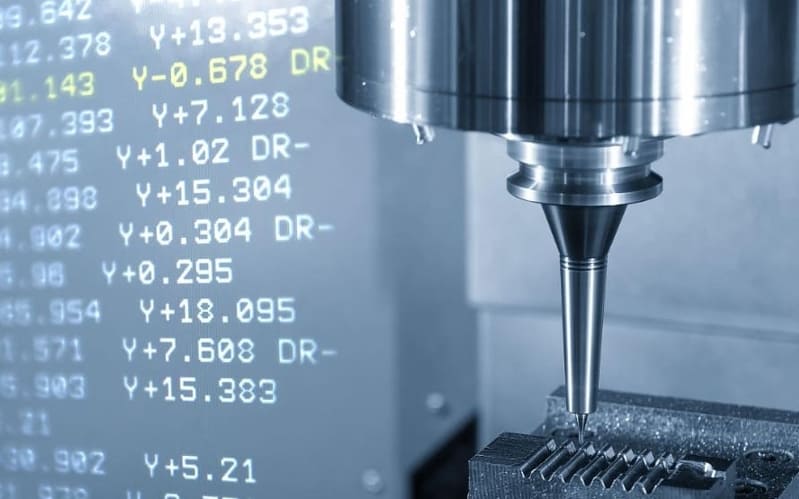
Mastering G-code allows for greater control over the machining process. Let’s explore how this programming language works and why it’s essential for CNC manufacturing.
1. What is G-code?
G-code (Geometric Code) is a numerical control programming language that tells a CNC machine how to move. It defines:
✅ Toolpaths (X, Y, Z movements)
✅ Cutting speeds and feed rates
✅ Spindle rotation speed and direction
✅ Coolant and tool changes
2. Common G-code Commands
G00 (Rapid Positioning): Moves the tool quickly to a specified position.
G01 (Linear Interpolation): Moves the tool in a straight line at a controlled speed.
G02/G03 (Circular Interpolation): Cuts circular arcs in a clockwise or counterclockwise direction.
G17, G18, G19: Selects different machining planes (XY, XZ, YZ).
3. M-code (Miscellaneous Code)
M-codes control non-cutting machine functions, such as:
M03/M04: Spindle on (clockwise/counterclockwise).
M05: Spindle off.
M08/M09: Coolant on/off.
M30: End of program.
Understanding G-code and M-code is crucial for CNC operators and programmers to optimize machining performance.
How precise is CNC precision machining?
Precision is what sets CNC machining apart from traditional manufacturing methods. But just how accurate can CNC machines get? The level of precision achieved determines whether a part meets strict industry standards.
CNC precision machining achieve tolerances as tight as ±0.001mm, making it ideal for applications requiring extreme accuracy, such as aerospace and medical components.
1. Factors Affecting CNC Precision
Several factors influence the accuracy of CNC machining, including:
✅ Machine Calibration: Regular maintenance and alignment improve precision.
✅ Tooling Quality: High-quality cutting tools reduce errors and ensure consistent results.
✅ Environmental Conditions: Temperature fluctuations and vibrations can affect machining accuracy.
✅ Material Properties: Hardness and thermal expansion impact machining tolerances.
2. Why High Precision Matters
Industries such as aerospace, medical, and automotive require CNC-machined parts with extreme precision to ensure safety, performance, and reliability.
What are the measuring tools used in CNC?
Achieving precision in CNC machining requires more than just advanced machinery—it also depends on accurate measurement. But what tools are used to verify dimensions and tolerances? High-quality measuring tools are essential for maintaining manufacturing standards.
Common measuring tools include calipers, micrometers, coordinate measuring machines (CMM), and optical comparators. These tools help verify dimensional accuracy and maintain strict quality control.
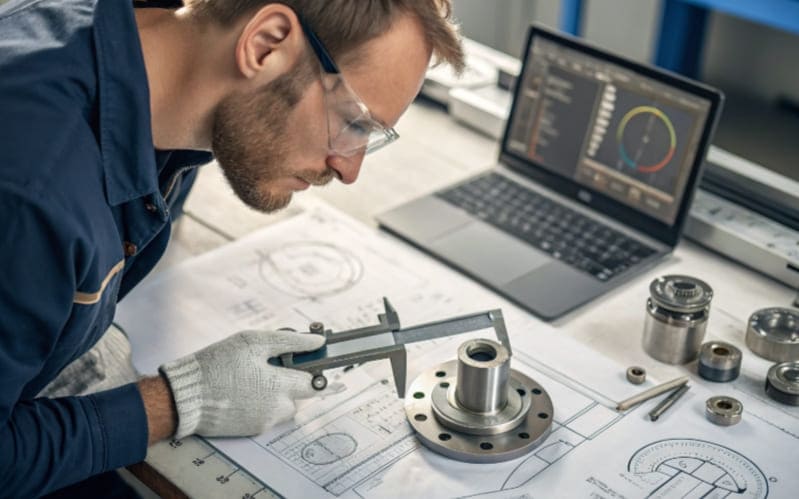
1. Key Measurement Tools in CNC Machining
Calipers: Measure external and internal dimensions with an accuracy of ±0.02mm.
Micrometers: Provide highly precise measurements down to ±0.001mm.
Coordinate Measuring Machines (CMM): Use probes to measure complex geometries.
Optical Comparators: Use light and magnification for inspecting small parts.
Height Gauges: Ensure correct vertical measurements of parts.
2. Importance of Quality Control in CNC
Regular measurement ensures:
✅ Consistency in production
✅ Compliance with design specifications
✅ Reduced errors and material waste
What is the surface finish of CNC machining?
Surface finish plays a crucial role in the performance and aesthetics of machined parts. A rough surface can increase friction, while a smooth finish enhances functionality. But what levels of surface finish can CNC machining achieve?
CNC machining can produce surface finishes ranging from rough (Ra 3.2μm) to mirror-like (Ra 0.2μm), depending on tooling, feed rate, and post-processing techniques.
Common CNC Surface Finishes
As-Machined (Ra 3.2μm – 6.3μm): Standard CNC finish with visible tool marks.
Bead Blasting (Ra 2.5μm – 3.2μm): Creates a matte texture by spraying fine abrasive material.
Anodizing (Ra 0.8μm – 1.6μm): Adds a protective oxide layer to aluminum parts.
Polishing (Ra 0.2μm – 0.4μm): Achieves a mirror-like surface with ultra-smooth texture.
Choosing the right surface finish impacts corrosion resistance, wear resistance, and aesthetics.
What are the advantages of CNC precision machining?
Manufacturers worldwide rely on CNC precision machining, but what makes it superior to other production methods? From cost efficiency to high accuracy, CNC machining offers numerous advantages over traditional manufacturing techniques.
CNC precision machining offers high accuracy, repeatability, efficiency, and flexibility in producing complex geometries with minimal waste, making it ideal for high-quality production.
1. Key Benefits of CNC Machining
✅ High Precision: Achieves tight tolerances (±0.001mm).
✅ Consistency: Ensures repeatability for large-scale production.
✅ Efficiency: Automated operation reduces lead times.
✅ Flexibility: Suitable for complex designs and diverse materials.
✅ Minimal Waste: Optimized cutting paths reduce material wastage.
These advantages make CNC machining a preferred choice in industries such as aerospace, medical, and automotive manufacturing.
What is 3-axis, 4-axis, 5-axis CNC machining?
Not all CNC machines are created equal—some are more advanced than others. But what’s the difference between 3-axis, 4-axis, and 5-axis CNC machining? Understanding these configurations is crucial for choosing the right machine for complex parts.
3-axis machining moves along X, Y, and Z directions, while 4-axis adds rotation, and 5-axis allows simultaneous multi-directional movement, enabling complex geometries and enhanced precision.

1. Comparison of CNC Axes
3-Axis CNC: Moves in three directions (X, Y, Z). Best for simple parts.
4-Axis CNC: Adds rotation around the X-axis (A-axis). Used for curved surfaces.
5-Axis CNC: Allows rotation on two axes (A & B), enabling intricate designs.
2. Applications of Multi-Axis Machining
✅ 3-Axis: Basic milling and drilling operations.
✅ 4-Axis: Turbine blades, medical implants.
✅ 5-Axis: Aerospace components, complex molds.
The more axes a CNC machine has, the greater its capability for producing intricate and high-precision parts.
Conclusion
CNC precision machining is a vital technology in modern manufacturing, offering high accuracy and efficiency across industries. By understanding its processes, materials, tolerances, and machine types, businesses can make informed decisions to enhance their production capabilities. Whether in aerospace, medical, or automotive industries, CNC machining continues to drive innovation and precision in manufacturing.
